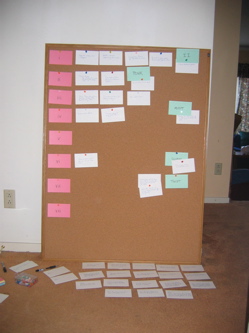At the moment I hate Movable Type in a way I have never, ever hated it before. I would move to WordPress in a second, except I cannot figure out how to use MySQL on our server (our server runs Mac OS X, in case anyone out there can give me a clue what to do to create a MySQL database). All I wanted to do was install a little doohickey to show my current word count, and after saving and rebuilding the Main Index about 3000 times, what I ended with was a ridiculously bollixed up thermometer, when all I wanted was:
|
(Damn. Still messed up! I don’t know what the deal is.)
One of my biggest problems with doing anything on our server at the moment is that when I ask the IT guy for our server for any help, he responds with something like, “Does this have anything to do with OpenSource???” Unless I get an account on #irc, I have to figure this out myself.
Anyhow. I’m very frustrated, because I really dislike Movable Type at the moment and there doesn’t seem to be much I can do about it.
§
I have continued writing, although as you can see from my word count that I haven’t made significant progress since November. Well, I have—it’s just that I rewrite so severely I haven’t managed to move too far upstream.
I have to stop doing that. I need to finish. If for no other reason than at this point, to prove to myself that I actually can. I still wonder if there’s some marvelous secret out there that I’ve never found out.
I’m not even trying to write the Great American Novel. I really just want it to be entertaining. And coherent. Sigh.
§
On Wordplay, Terry Rossio has often talked about using index cards and a corkboard to outline his projects. Pin the index cards to said board, see how it all falls out. Easier to rearrange index cards than gigantic chunks of text.
I bought the corkboard, but I bought it so long ago I may have been childless. Never used it. Wasn’t even sure how to use, really—am I just supposed to lay everything out in order? That doesn’t tell me much about the structure, does it?
I knew I was really, really frustrated with my rewrite of my novel when I whipped out the index cards and the corkboard. Because at the moment, I’m ready to try anything. I feel like I’m the only person in the world who can’t do this.

(This is actually the board from the middle of May, when I originally took this picture and wrote this entry. Things have changed somewhat since then.)
Before even approaching the board, I arranged the cards in the best order I could. And it didn’t take that long to see the problem. It’s an Act II problem, of course.
If I ever figure out a way to make Act II my friend, I am going to make millions of dollars. Because everyone (with the possible exception of Toni, who has been heard to claim to have fewer problems with Act II than Act I) has problems with Act II. It’s the Sahara Desert of the story.
A popular summary of story structure is:
- Act I: Get your hero up a tree.
- Act II: Throw rocks at your hero.
- Act III: Get your hero down out of the tree.
Okay. Throw rocks = Complicate things. But not randomly: the complications have to be story-related, of course. And it can’t just be “one damn thing after another,” they have to make things much, much worse for your hero. Within the boundaries of the storyworld.
I broke down and arranged my story in the 8 sequences of the USC story structure. (This division works out quite well with a screenplay: each sequence has roughly 15 pages, and a 15 page chunk is a heck of a lot easier to tackle than a 120-page monster, fer shur. And of course the eighth sequence isn’t going to be as long as the others, because these days you end the movie and get out—no long wrap-ups for our audiences, no sirree.) It’s clear as day where the pacing in my story falls apart, where I’m plot heavy, where I need to figure things out some.
One thing that was bugging me was the end of Act 2. It wasn’t strong enough, the way I had it, and I really needed something to send me off into the final wrap-up of Act 3.
One “tip” I heard somewhere—USC? Wordplay?—is that the end of Act 2 is the alternate ending of the movie: that is, if your movie ends happily, the end of Act 2 is where you show us how things would end if they ended badly. (And likewise, if your movie ends tragically, give us the happy ending here.) It’s where the lovers in the rom-com are separated or realize they can never be together or whatever. In Macbeth, it’s where he realizes that he’s safe, he’s gotten away with it, because no one can ever defeat him—only a man not born of woman can beat him and hey, no such thing. (Boy, does he have a surprise coming!)
§
Anyhow. I have vowed to myself to send my work out this year, start racking up the responses. I definitely have to get this one out the door before November, because I am so looking forward to doing NaNoWriMo again.